#remote patient monitoring examples
Explore tagged Tumblr posts
Text
Akso Hospital

Location: Downtown Linkon City
Clinic Number: 2122637824
Mottos:
"Akso Hospital, for a brighter future"
"For A Better Future of Life"
"Akso Hospital Cares"
Details:
Okay, this is going to be a long one. Rather than try to cram everything into one huge post, I'll be splitting it up into a series of posts to sufficiently cover everything. I'll list the link menu at the bottom of this main post. But first, let's go over the general details of Akso Hospital!
Linkon's municipal hospital, located downtown. A facility focused on medicine, research, and education. Its divisions, such as the Division of Cardiac Surgery and Division of General Surgery, are widely respected. At the forefront of healthcare, it is a world-renowned medical institute.
Features & Facts:
It has its own Flux Stabilizer
The Akso Remote Monitor is a hospital took used for monitoring the health status of remote patients
It has a rooftop helipad with at least two rescue helicopters
Akso Hospital has at least 11 confirmed floors
Patient visits are half an hour
Akso Hospital has a partnership with the Hunter's Association
Akso Hospital has a "Moments" profile with the name "Akso Hospital Official"; One identified writer for this profile has the username "AksoHospitalAssistant"
The protaganist mentions a waiting area with a TV that plays movies. According to Zayne, there's also popcorn in a vending machine next to the nurse's station.


Events:
Hospital Staff's Lottery: This year, the grand prize was a hot springs trip for two. Zayne won.
Patient's Favorite Doctor: An annual public poll the hospital releases. The protaganist says the votes showed Zayne was very popular this year. The winner will be forced to appear in the hospital's promotional videos (a detail Zayne is not excited about lol)


Health Initiatives:
Zayne says the hospital has many health initiatives. But these are the ones specifically mentioned by name:
The Mindfulness Chamber: a mindfulness initiative
Get Out of Bed: an encouragement initiative
Floorplan:
At Akso Hospital, floors are denoted with a letter (possibly indicating the specific building or wing?) followed by the floor number. Rooms, offices, or defined areas on that floor are two-digit numbers. (For example, Room 2 on the fifth floor of building B would likely be written as "B6/B06, Room B02".)
Here are some Akso Hospital room locations I was able to confirm throughout the game:
Floor A8/A08:
00-03: Diagnosis Rooms
02: Division of Cardiac Surgery
04-06: Doctor's Offices


Floor A4/A04:
Reception where Yvonne works
Zayne's check up room is on floor A4
017: Radiotherapy

Link Menu:
Archives
Cafeteria
Clinical Research Center
Division of General Surgery
Division of Cardiac Surgery
Division of Evol and Protocore Medical Technology
Emergency Room
Evol-Cardiac Medical Research Lab
Garden
Gynecology
Inpatient Building
Neurology and Sleep Center
Orthopedics
Pediatrics & Pediatric Ward
Public Relations Division
Radiology
Radiotherapy
Rehabilitation Center
Surgery Center
(In-Game Medical Glossary)
25 notes
·
View notes
Text
MedAI by Tech4Biz Solutions: Pioneering Next-Gen Medical Technologies

The healthcare industry is undergoing a seismic shift as advanced technologies continue to transform the way care is delivered. MedAI by Tech4Biz Solutions is at the forefront of this revolution, leveraging artificial intelligence and cutting-edge tools to develop next-generation medical solutions. By enhancing diagnostics, personalizing patient care, and streamlining operations, MedAI is empowering healthcare providers to deliver better outcomes.
1. AI-Driven Medical Insights
MedAI harnesses the power of artificial intelligence to analyze complex medical data and generate actionable insights. Its advanced algorithms can detect anomalies, predict disease progression, and recommend treatment pathways with unprecedented accuracy.
Case Study: A large medical center integrated MedAI’s diagnostic platform, leading to:
Faster identification of rare conditions.
A 30% reduction in misdiagnoses.
Enhanced clinician confidence in treatment decisions.
These capabilities underscore MedAI’s role in advancing clinical decision-making.
2. Personalized Patient Care
Personalization is key to modern healthcare, and MedAI’s data-driven approach ensures treatment plans are tailored to individual needs. By analyzing patient histories, lifestyle factors, and genetic data, MedAI offers more targeted and effective interventions.
Example: A chronic disease management clinic used MedAI to create personalized care plans, resulting in:
Improved medication adherence.
Decreased hospital readmission rates.
Greater patient satisfaction and engagement.
MedAI’s solutions allow providers to offer more precise, patient-centered care.
3. Enhanced Operational Efficiency
MedAI goes beyond clinical improvements by optimizing healthcare operations. Its automation tools reduce administrative burdens, freeing healthcare professionals to focus on patient care.
Insight: A regional hospital implemented MedAI’s workflow automation system, achieving:
A 40% reduction in administrative errors.
Faster patient registration and billing processes.
Streamlined appointment scheduling.
These improvements enhance overall operational efficiency and patient experiences.
4. Advanced Predictive Analytics
Predictive analytics play a vital role in preventive care. MedAI’s algorithms identify patients at high risk of developing chronic conditions, enabling early interventions.
Case Study: A primary care network used MedAI’s predictive models to monitor high-risk patients, leading to:
Early lifestyle adjustments and medical interventions.
A 25% drop in emergency room visits.
Higher enrollment in wellness programs.
By shifting to proactive care, MedAI helps reduce healthcare costs and improve long-term outcomes.
5. Revolutionizing Telemedicine
The rise of telemedicine has been accelerated by MedAI’s AI-powered virtual care solutions. These tools enhance remote consultations by providing real-time patient insights and symptom analysis.
Example: A telehealth provider adopted MedAI’s platform and reported:
Improved diagnostic accuracy during virtual visits.
Reduced wait times for consultations.
Increased access to care for rural and underserved populations.
MedAI’s telemedicine tools ensure equitable, high-quality virtual care for all.
6. Streamlining Drug Development
MedAI accelerates the drug discovery process by analyzing clinical trial data and simulating drug interactions. Its AI models help identify promising compounds faster and improve trial success rates.
Case Study: A pharmaceutical company partnered with MedAI to enhance its drug development process, achieving:
Faster identification of viable drug candidates.
Shorter trial durations.
Reduced costs associated with trial phases.
These innovations are driving faster development of life-saving medications.
7. Natural Language Processing for Clinical Data
MedAI’s natural language processing (NLP) capabilities extract insights from unstructured medical data, such as physician notes and discharge summaries. This allows for faster retrieval of vital patient information.
Insight: A healthcare system implemented MedAI’s NLP engine and experienced:
Improved documentation accuracy.
Quicker clinical decision-making.
Enhanced risk assessment for high-priority cases.
By automating data extraction, MedAI reduces clinician workloads and improves care quality.
8. Robust Data Security and Compliance
Data security is paramount in healthcare. MedAI employs advanced encryption, threat monitoring, and regulatory compliance measures to safeguard patient information.
Example: A hospital using MedAI’s security solutions reported:
Early detection of potential data breaches.
Full compliance with healthcare privacy regulations.
Increased patient trust and confidence in data protection.
MedAI ensures that sensitive medical data remains secure in an evolving digital landscape.
Conclusion
MedAI by Tech4Biz Solutions is redefining healthcare through its pioneering medical technologies. By delivering AI-driven insights, personalized care, operational efficiency, and robust security, MedAI empowers healthcare providers to navigate the future of medicine with confidence.
As healthcare continues to evolve, MedAI remains a trailblazer, driving innovation that transforms patient care and outcomes. Explore MedAI’s comprehensive solutions today and discover the next frontier of medical excellence.
For More Reachout :https://medai.tech4bizsolutions.com/
3 notes
·
View notes
Text
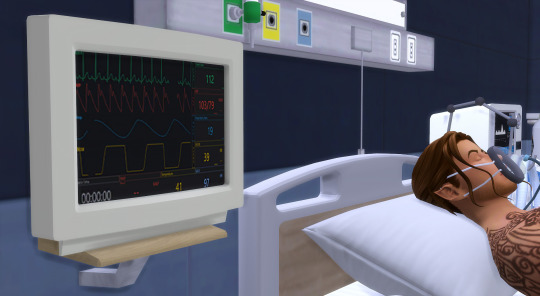

now I have spent... an amount of time trying to find something remotely close to what you'd see on a typical patient monitor. The swatches that were there, well, it wasn't what I wanted/needed. Long story short, I had to download some programs and mess around with it.
I'm not sure what to go with. the top one is the most detailed (but the most complicated to set up, holy shit), while the bottom one is simple and it's got enough numbers and such to look like a monitor.
I have a few questions to ask--
how do I get the display to look clear/crispy? I had to shrink the images to fit and they look crunchy.
there's a tv I wanna use as a bigger monitor (Spacekeeper Mountable TV) but I don't know how to add a texture to it (for example the Top Secret Monitor has a texture slot for the display if that makes sense)
#ts4#the sims 4#sims 4#simblr#oc: john#i need to browse foxbury because s4s is uh... i can't comprehend their explanations lol#all this for a easily missed detail or what if someone reads it and goes 'wait wtf'#getting caught up in the deets as usual
14 notes
·
View notes
Text
From Data to Decisions: Leveraging IoMT for Improved Healthcare Outcomes
The article explores how the Internet of Medical Things (IoMT) is transforming healthcare by enabling remote patient monitoring, enhancing chronic disease management, and optimizing smart hospital operations. It delves into the benefits, challenges, regulatory aspects, and future potential of IoMT integrated with AI and blockchain technology.
Introduction:
The Internet of Medical Things (IoMT) represents a transformative leap in healthcare technology, connecting medical devices and applications to healthcare IT systems via networking technologies.This interconnected web of devices allows for the seamless collection, analysis, and sharing of health data, which in turn enhances healthcare outcomes.By harnessing the power of IoMT, healthcare providers can make more informed decisions, improve patient care, and optimize operational efficiency.
The Role of IoMT in Healthcare
IoMT spans a vast array of devices, from wearable fitness trackers to advanced medical imaging equipment, all of which generate and transmit data that can be analyzed for critical insights.
Here’s how IoMT is revolutionizing various aspects of healthcare:
Remote Patient Monitoring (RPM): Imagine a scenario where your vital signs, such as heart rate, blood pressure, and glucose levels, are constantly monitored without frequent visits to a clinic.RPM enables this by using devices like continuous glucose monitors and smart heart rate sensors.Read more>>
Chronic Disease Management: Managing chronic conditions like diabetes, heart disease, and chronic obstructive pulmonary disease (COPD) becomes significantly more effective with IoMT. Devices provide continuous, detailed data on disease progression and treatment efficacy. Read more>>
Smart Hospitals: In a smart hospital, interconnected devices such as IV pumps, patient beds, and imaging equipment streamline operations and enhance patient safety.Smart beds can automatically adjust to prevent bedsores, while connected IV pumps can precisely control medication dosages, reducing the risk of human error. Read more>>
Benefits of IoMT
Improved Patient Outcomes: IoMT facilitates early detection of potential health issues through continuous monitoring, allowing for preventive care and reducing the need for emergency interventions.For example, patients at risk of heart failure can be monitored for signs of deterioration, enabling early intervention and potentially life-saving treatment. Read more>>
Cost Reduction: By enabling remote monitoring and early intervention, IoMT significantly reduces the frequency of hospital readmissions.This not only improves patient outcomes but also alleviates the financial strain on healthcare systems.For instance, patients with chronic conditions can be managed at home, reducing the need for expensive hospital stays. Read more>>
Better Decision-Making: The advanced analytics on data collected from IoMT devices provide actionable insights for healthcare providers.For example, data from wearable devices can be analyzed to detect early signs of health deterioration, enabling timely intervention.Similarly, data from smart hospital equipment can help identify patterns and trends that inform clinical decisions. Read more>>
Challenges and Solutions
While the benefits of IoMT are clear, several challenges need to be addressed for its widespread adoption:
Data Security and Privacy: The vast amount of data generated by IoMT devices poses significant security and privacy risks.Personal health information must be protected to prevent unauthorized access and breaches. Read more>>
Interoperability: Different IoMT devices and systems often use varying protocols, making it difficult to integrate data seamlessly.For instance, a patient’s wearable fitness tracker may not easily communicate with the hospital’s electronic health record (EHR) system. Read more>>
Regulatory Compliance: IoMT devices must comply with stringent regulatory requirements to ensure patient safety and data privacy. This includes obtaining necessary certifications and adhering to standards set by regulatory bodies such as the FDA and EMA. Read more>>
The Future of IoMT in Healthcare
The future of IoMT is promising, with advancements in artificial intelligence (AI) and machine learning (ML) poised to enhance its capabilities further.AI-driven analytics can provide deeper insights into patient data, predicting potential health issues before they arise and enabling more personalized care. Read more>> More Articles
Health Information Exchange (HIE): A New Era of Collaborative Healthcare
Know the Difference: CT Angiography (CTA) and MRI Angiography (MRA)
Smart Hospitals: Integrating Technology into Healthcare Design

2 notes
·
View notes
Text

New study challenges conventional understanding of charging process in electrochemical devices
A new study by researchers at the University of Cambridge reveals a surprising discovery that could transform the future of electrochemical devices. The findings offer new opportunities for the development of advanced materials and improved performance in fields such as energy storage, brain-like computing, and bioelectronics. Electrochemical devices rely on the movement of charged particles, both ions and electrons, to function properly. However, understanding how these charged particles move together has presented a significant challenge, hindering progress in creating new materials for these devices. In the rapidly evolving field of bioelectronics, soft conductive materials known as conjugated polymers are used for developing medical devices that can be used outside of traditional clinical settings. For example, this type of materials can be used to make wearable sensors that monitor patients' health remotely or implantable devices that actively treat disease. The greatest benefit of using conjugated polymer electrodes for this kind of devices is their ability to seamlessly couple ions, responsible for electrical signals in the brain and body, with electrons, the carriers of electrical signals in electronic devices. This synergy improves the connection between the brain and medical devices, effectively translating between these two types of signals.
Read more.
#Materials Science#Science#Electrochemistry#Bioelectronics#Conjugated polymers#Polymers#University of Cambridge
11 notes
·
View notes
Text
Public Health Campaigns & Communities
What is public health?
Public health, as a multidisciplinary field, is dedicated to enhancing the health and overall well-being of communities (Lee, 2023). It strives to create safe environments for people to live, learn, work, and enjoy their lives. Many people mistakenly believe that public health is the same as healthcare. However, it is important to distinguish between the two, as public health focuses on entire populations with the objective of preventing illnesses and injuries, while the healthcare industry concentrates on treating individual patients who are already sick (APHA, 2023).
For example, public health is responsible for the following:

"Public health is the science and art of preventing disease, prolonging life, and promoting health through the organized efforts and informed choices of society, organizations, public and private communities, and individuals." — Winslow, 1920
The 10 Essential Public Health Services
The 10 Essential Public Health Services (EPHS), first created in 1994 by a federal working group, serves as the description of the activities that public health systems should undertake in all communities. EPHS is organised around the three core functions of public health: assessment, policy development and assurance. Health departments and community partners collaborators across the nation structure their work around the EPHS model, while educational institutions and public health programs also incorporate it into their teachings (CDC, 2023).
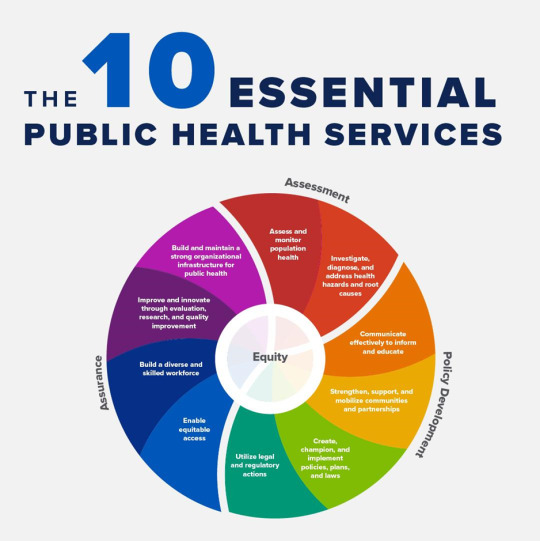
In 2020, a revised version of the 10 EPHS was unveiled during a virtual launch event. The revised EPHS centres around equity and promotes policies that enable optimal health for all and seek to remove systemic and structural barriers such as poverty, racism, gender discrimination and others, that have resulted in health inequities (CDC, 2023).
“The revised 10 EPHS not only centres equity but acknowledges the importance of community voice and the different roles public health plays.” — Jessica Fisher, Vice President of Strategic Initiatives at Public Health National Center for Innovations (PHNCI).
COVID-19 and Public Health
COVID-19, caused by an infection of the SARS-CoV-2 virus, was initially detected in December 2019 in Wuhan, a city in China's Hubei province. The COVID-19 pandemic has posed a substantial threat to nations across the world, and it is regarded as the biggest public health crisis the world has confronted in over a century (Miyah, 2022). In late 2020, the World Health Organisation (WHO) declared the COVID-19 outbreak as a Public Health Emergency of International Concern in which countries with vulnerable healthcare facilities may be at an excessive hazard (Tabari, 2020).
In response to this crisis, many countries have enacted travel restrictions, including flight suspensions and measures to limit incoming travellers. Others have introduced social distancing and quarantine policies as well as encouraging the reduction of social interactions, postponing events, locking down schools, and isolating suspected cases. Furthermore, some regions have utilized telemedicine for remote consultations and monitoring during the outbreak (Tabari, 2020).
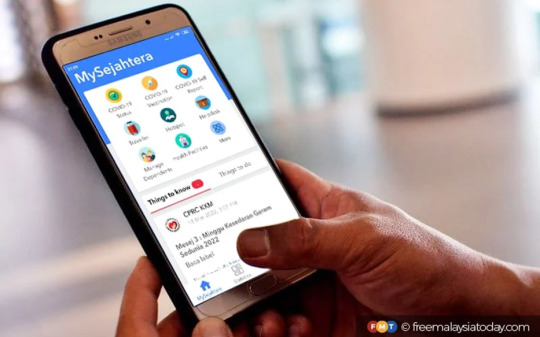
MySejahtera is a mobile app developed by the Malaysian government to support various aspects of public health throughout the COVID-19 pandemic. This app enables citizens to conduct self-health assessments, track their health status, and communicate information with the Ministry of Health (MOH), so that necessary actions could be implemented.
Here are its primary functions:
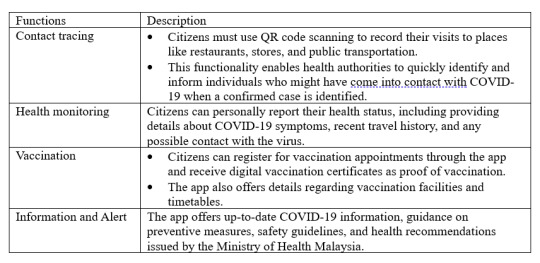
Explore https://www.maaedicare.org/wp-content/uploads/2021/11/MySejahtera_compressed.pdf for detailed function and process of using MySejahtera.
Mental Health Problem Attribute to Social Media
Last but not least, mental health is a crucial aspect of public health, and the well-being of individuals, particularly those in the 16-24 age group, is a matter of significant concern. A survey conducted in Malaysia in May 2022 revealed that a considerable portion of young respondents in this age range reported experiencing heightened levels of stress and anxiety over the past year (Statista Research Department, 2023). Furthermore, this research suggests that social media plays a substantial role in contributing to this mental health problem.
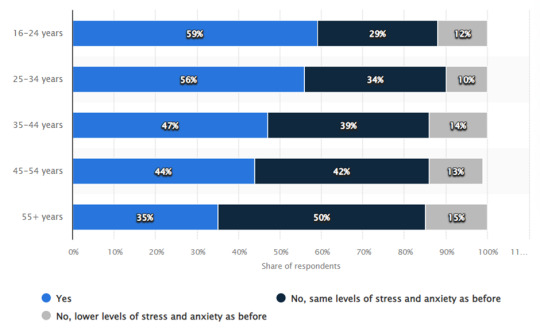
Source: Statista Research Department, 2023
Multiple studies have demonstrated a strong connection between heavy use of social media and the risk for mental health issues (Robinson, 2023). Social media platforms can be hotspots for the dissemination of hurtful rumours, lies and online harassment. About 10 percent of teens report being bullied on social media and many other users are subjected to offensive comments (Robinson, 2023). Additionally, fear of missing out (FOMO) can compel someone to pick up their phone every few minutes to check for updates, or compulsively respond to every alert. When individuals prioritize online interactions over in-person relationships, they become more vulnerable to mood disorders, such as anxiety and depression.

These findings highlight the importance of recognizing the influence of social media on mental health, especially among young adults. In summary, striking a balance between the advantages of digital connectivity and the preservation of mental well-being is crucial to ensure that social media serves as a positive and constructive tool in the lives of young individuals.
References:
American Public Health Association. (n.d.). What is public health. https://www.apha.org/what-is-public-health
CDC. (2021). Public health system and the 10 essential public health services. Centers for Disease Control and Prevention. https://www.cdc.gov/publichealthgateway/publichealthservices/essentialhealthservices.html
C.-E. A. Winslow, The Untilled Fields of Public Health.Science51,23-33(1920).DOI:10.1126/science.51.1306.23
Lee, D., Chen, K., & Kruger, J. S. (2023, January 1). Chapter 93 - Public health (A. E. M. Eltorai, J. A. Bakal, P. C. Newell, & A. J. Osband, Eds.). ScienceDirect; Academic Press. https://www.sciencedirect.com/science/article/abs/pii/B9780323903004000616
Malaysia: stress levels by age group 2022. (2023, August 25). Statista. https://www.statista.com/statistics/1322323/malaysia-share-of-people-feeling-more-stressed-or-anxious-by-gender/#:~:text=According%20to%20a%20survey%20on
Miyah, Y., Benjelloun, M., Lairini, S., & Lahrichi, A. (2022). COVID-19 Impact on Public Health, Environment, Human Psychology, Global Socioeconomy, and Education. TheScientificWorldJournal, 2022, 5578284. https://doi.org/10.1155/2022/5578284
Robinson, L., & Smith, M. (2020, September). Social Media and Mental Health - HelpGuide.org. Https://Www.helpguide.org. https://www.helpguide.org/articles/mental-health/social-media-and-mental-health.htm#:~:text=Since%20it
Tabari, P., Amini, M., Moghadami, M., & Moosavi, M. (2020). International Public Health Responses to COVID-19 Outbreak: A Rapid Review. Iranian journal of medical sciences, 45(3), 157–169. https://doi.org/10.30476/ijms.2020.85810.1537
World Health Organization (WHO). (2022, June 17). Mental Health. World Health Organization. https://www.who.int/news-room/fact-sheets/detail/mental-health-strengthening-our-response
2 notes
·
View notes
Text
Monitoring health care safety using SEnergy IoT
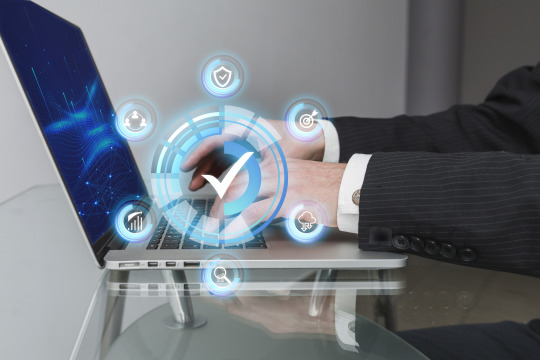
Monitoring healthcare safety using IoT (Internet of Things) technology, including SEnergy IoT, can greatly enhance patient care, streamline operations, and improve overall safety in healthcare facilities. SEnergy IoT, if specialized for healthcare applications, can offer several advantages in this context. Here's how monitoring healthcare safety using SEnergy IoT can be beneficial:
Patient Monitoring: SEnergy IoT can be used to monitor patient vital signs in real-time. Wearable devices equipped with sensors can track heart rate, blood pressure, temperature, and other critical parameters. Any deviations from normal values can trigger alerts to healthcare providers, allowing for timely intervention.
Fall Detection: IoT sensors, including accelerometers and motion detectors, can be used to detect falls in patients, especially the elderly or those with mobility issues. Alerts can be sent to healthcare staff, reducing response times and minimizing the risk of injuries.
Medication Management: IoT can be used to ensure medication adherence. Smart pill dispensers can remind patients to take their medications, dispense the correct dosage, and send notifications to caregivers or healthcare providers in case of missed doses.
Infection Control: SEnergy IoT can help monitor and control infections within healthcare facilities. Smart sensors can track hand hygiene compliance, air quality, and the movement of personnel and patients, helping to identify and mitigate potential sources of infection.
Asset Tracking: IoT can be used to track and manage medical equipment and supplies, ensuring that critical resources are always available when needed. This can reduce the risk of equipment shortages or misplacement.
Environmental Monitoring: SEnergy IoT can monitor environmental factors such as temperature, humidity, and air quality in healthcare facilities. This is crucial for maintaining the integrity of medications, medical devices, and the comfort of patients and staff.
Security and Access Control: IoT can enhance security within healthcare facilities by providing access control systems that use biometrics or smart cards. It can also monitor unauthorized access to sensitive areas and send alerts in real-time.
Patient Privacy: SEnergy IoT can help ensure patient privacy and data security by implementing robust encryption and access control measures for healthcare data transmitted over the network.
Predictive Maintenance: IoT sensors can be used to monitor the condition of critical equipment and predict when maintenance is needed. This proactive approach can reduce downtime and improve the safety of medical devices.
Emergency Response: In case of emergencies, SEnergy IoT can automatically trigger alerts and initiate emergency response protocols. For example, in the event of a fire, IoT sensors can detect smoke or elevated temperatures and activate alarms and evacuation procedures.
Data Analytics: The data collected through SEnergy IoT devices can be analyzed to identify trends, patterns, and anomalies. This can help healthcare providers make informed decisions, improve patient outcomes, and enhance safety protocols.
Remote Monitoring: IoT enables remote monitoring of patients, allowing healthcare providers to keep an eye on patients' health and well-being even when they are not in a healthcare facility.
Compliance and Reporting: SEnergy IoT can facilitate compliance with regulatory requirements by automating data collection and reporting processes, reducing the risk of errors and non-compliance.
To effectively implement SEnergy IoT for healthcare safety, it's crucial to address privacy and security concerns, ensure interoperability among various devices and systems, and establish clear protocols for responding to alerts and data analysis. Additionally, healthcare professionals should be trained in using IoT solutions to maximize their benefits and ensure patient safety.
2 notes
·
View notes
Text
My Journey with Azure IoT Hub: Connecting and Managing IoT Devices at Scale
The Internet of Things (IoT), which enables seamless connectivity and automation across numerous industries, has completely changed the way we engage with technology. I was curious to learn more about the Internet of Things and its possible uses as an aspiring IoT enthusiast. My experience using Azure IoT Hub, Microsoft’s cloud-based IoT platform, and how it assisted me in connecting and managing IoT devices at scale are both discussed in this blog.
Getting Started with Azure IoT Hub

To embark on my IoT journey, I began by understanding the fundamentals of Azure IoT Hub. Azure IoT Hub is a fully managed service that acts as a central hub for bi-directional communication between IoT devices and the cloud. It provides secure, reliable, and scalable connectivity for IoT solutions. Setting up an Azure IoT Hub was my first step. While the process was relatively straightforward, I encountered a few challenges along the way.
Connecting IoT Devices
Once Azure IoT Hub was set up, I delved into the world of IoT devices. I worked with various types of IoT devices, ranging from simple sensors to complex industrial machines. Connecting these devices to Azure IoT Hub required the implementation of device-specific protocols such as MQTT or HTTP. Additionally, I focused on securing device connections and data transmission by utilizing security features provided by Azure IoT Hub.
Real-world examples of IoT devices connected to Azure IoT Hub are aplenty. For instance, in the healthcare industry, wearable devices can transmit patient vitals to Azure IoT Hub, allowing healthcare providers to monitor and respond to critical situations promptly. In smart homes, IoT devices such as thermostats and security cameras can be connected to Azure IoT Hub, enabling remote control and monitoring capabilities.
Managing IoT Devices at Scale
As my IoT project grew, I encountered the need to scale up the number of connected devices. Azure IoT Hub offered robust device management features that simplified the process of managing a large fleet of devices. I could remotely monitor the health, status, and firmware version of each device, enabling efficient troubleshooting and maintenance. Implementing best practices for device management, such as grouping devices based on location or functionality, enhanced the overall operational efficiency of my IoT solution.
Data Ingestion and Processing
Data collected from IoT devices is a valuable asset that can drive actionable insights and informed decision-making. Azure IoT Hub facilitated the ingestion and routing of data to Azure services for further processing and analysis. I had the opportunity to work with Azure Stream Analytics and Azure Functions, which enabled real-time data processing, transformation, and visualization. Leveraging these services allowed me to unlock the true potential of IoT data and derive meaningful insights.
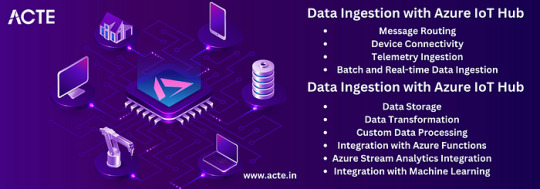
Security and Compliance
Any IoT solution must prioritize security. Azure IoT Hub provided robust security features that ensured end-to-end protection of IoT deployments. These features included device authentication, message encryption, and integration with Azure Active Directory for access control. Additionally, Azure IoT Hub helped me meet compliance and regulatory requirements by providing built-in support for industry standards such as ISO 27001, HIPAA, and GDPR. Throughout my journey, I learned valuable lessons and implemented best practices for securing IoT solutions.
Scalability and Performance
Scaling an IoT solution to handle thousands or millions of devices is a complex task. Azure IoT Hub offered scalability features that allowed me to effortlessly handle large-scale IoT deployments. With Azure IoT Hub’s device-to-cloud messaging capabilities, I could reliably transmit messages to and from a massive number of devices. Moreover, I gained insights into optimizing IoT solutions for performance by considering factors such as message size, frequency, and device capabilities.
Real-World Use Cases
To understand the versatility of Azure IoT Hub, it is crucial to explore real-world use cases. In the manufacturing industry, Azure IoT Hub can be leveraged to connect and monitor machines on the factory floor, ensuring optimal performance and predictive maintenance. In the agriculture sector, IoT devices connected to Azure IoT Hub can collect data on soil moisture levels, temperature, and humidity, enabling farmers to make data-driven decisions for irrigation and crop management. These use cases highlight the valuable role that Azure IoT Hub plays in various domains and industries.
Future of IoT and Azure IoT Hub
The future of IoT is promising, with emerging trends shaping the landscape. As IoT continues to evolve, Azure IoT Hub will play a crucial role in enabling seamless connectivity, advanced analytics, and artificial intelligence capabilities. Integration with other Azure services and continuous updates from Microsoft ensure that Azure IoT Hub remains at the forefront of IoT innovation. The possibilities for IoT applications are limitless, and Azure IoT Hub will continue to empower developers and organizations to build robust and scalable IoT solutions.
Throughout my journey with Azure IoT Hub, I gained valuable insights and experiences. Azure IoT Hub simplified the process of connecting and managing IoT devices, providing a reliable and scalable platform. The seamless integration with other Azure services allowed me to unlock the full potential of IoT data. Moreover, the security and compliance features provided peace of mind, ensuring that my IoT solution was protected from threats. Overall, Azure IoT Hub has been instrumental in my IoT journey, contributing to enhanced efficiency and productivity.
Recommendations and Tips
For those interested in starting their own IoT journey with Azure IoT Hub, I offer the following recommendations and tips:
Begin with a clear understanding of your IoT use case and requirements.
Familiarize yourself with the documentation and resources provided by Microsoft to gain a solid foundation.
Start small and gradually scale your IoT solution as needed.
Take advantage of the device management and security features offered by Azure IoT Hub.
Leverage other Azure services such as Azure Stream Analytics and Azure Functions to derive meaningful insights from IoT data.
Stay updated on emerging trends and best practices in the IoT space.
To deepen your knowledge of IoT and Azure IoT Hub, I recommend exploring Microsoft’s official documentation, participating in the ACTE Technologies Microsoft Azure training, and attending IoT-focused conferences and events.

Azure IoT Hub has proven to be a powerful and comprehensive platform for connecting and managing IoT devices at scale. Throughout my journey, I witnessed the transformative potential of IoT solutions and the crucial role played by Azure IoT Hub in enabling seamless connectivity, advanced analytics, and robust security. As IoT continues to evolve, Azure IoT Hub will undoubtedly remain at the forefront of IoT innovation, empowering organizations to build scalable and efficient IoT solutions. I encourage readers to embark on their own IoT journeys, leveraging the capabilities of Azure IoT Hub to unlock the full potential of IoT. Join me in embracing the future of IoT and revolutionizing industries through connected devices. Please leave your comments, stories, and inquiries in the space provided below. Let’s continue the conversation and explore the endless possibilities of IoT together.
#microsoft azure#cloud services#information technology#education#tech#technology#iot#innovation#cloud computing
5 notes
·
View notes
Text
Congestive Heart Failure Treatment Devices Market Trends, Size, Share, Trends and Future Opportunities 2034 : SPER Market Research
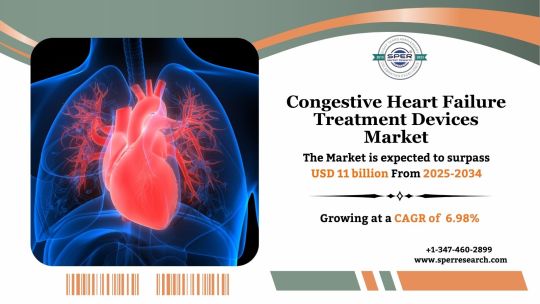
Congestive heart failure treatment devices are medical devices for congestive heart failure (CHF), a condition in which the heart finds it difficult to pump blood efficiently, are made to strengthen heart function and enhance circulation in individuals with CHF. These devices, which improve cardiac output and help control heart rhythms, include pacemakers, ventricular assist devices (VADs), implanted Cardioverter defibrillators (ICDs), and cardiac resynchronization treatment (CRT) devices. Furthermore, remote monitoring devices help identify worsening symptoms early. These tools are essential for treating CHF, lowering hospital stays, and enhancing patients' quality of life. Device technology is always evolving to improve long-term results for CHF patients, decrease complications, and increase efficiency.
According to SPER market research, ‘Global Congestive Heart Failure Treatment Devices Market Size- By Product - Regional Outlook, Competitive Strategies and Segment Forecast to 2033’ state that the Global Congestive Heart Failure Treatment Devices Market is predicted to reach 11 billion by 2034 with a CAGR of 6.98%.
Drivers:
Ventricular assist devices (VADs) and artificial heart pumps are two examples of technological developments in the treatment of heart failure that propel market expansion by enhancing patient outcomes and quality of life. An aging population is leading to the surge in demand for these devices, which is further fueled by the rising prevalence of cardiovascular disorders, especially heart failure. A key factor driving the sector is the ongoing development of heart failure treatment technologies, such as artificial heart pumps, ventricular assist devices (VADs), and minimally invasive alternatives. Significant progress has been made in treatment approaches as a result of the rising incidence of heart failure, especially in proactive care and early intervention.
Request a Free Sample Report: https://www.sperresearch.com/report-store/congestive-heart-failure-treatment-devices-market?sample=1
Restraints:
The market for congestive heart failure (CHF) therapy devices is confronted with various obstacles. Particularly in poor nations, the high expense of implanted devices such as cardiac resynchronization treatment (CRT) and left ventricular assist devices (LVADs) restricts accessibility. Long clinical trials and stringent regulatory permissions cause delays in product introductions. Patients are also at serious risk from device-related problems such thrombosis, infections, and mechanical failures. Market expansion is further hampered by low-income populations' lack of awareness and cost. Another factor influencing acceptance is the lack of qualified medical personnel for device administration and insertion. The broad use of CHF therapy devices is also being slowed by payment restrictions and changing healthcare regulations, which place a financial burden on both patients and providers.
The global market for congestive heart failure therapy devices was led by North America. An aging population, a high rate of heart disease, and sophisticated healthcare infrastructure are the main causes of this. Some significant market players are Abbott Laboratories, Biotronik SE & Co. KG, Boston Scientific Corporation, Koninkilijke Philips N.V.
For More Information, refer to below link: –
Congestive Heart Failure Treatment Devices Market Share
Related Reports:
Arbovirus Testing Market Growth, Size, Trends Analysis - By Test Type, By Pathogen Detection, By Technology, By Application - Regional Outlook, Competitive Strategies and Segment Forecast to 2034
Shingles Vaccine Market Growth, Size, Trends Analysis - By Product, By Vaccine Type - Regional Outlook, Competitive Strategies and Segment Forecast to 2034
Follow Us –
LinkedIn | Instagram | Facebook | Twitter
Contact Us:
Sara Lopes, Business Consultant — USA
SPER Market Research
+1–347–460–2899
#Congestive Heart Failure Treatment Devices Market#Congestive Heart Failure Treatment Devices Market Share#Congestive Heart Failure Treatment Devices Market Size#Congestive Heart Failure Treatment Devices Market Growth#Congestive Heart Failure Treatment Devices Market Demand#Congestive Heart Failure Treatment Devices Market Growing CAGR#Congestive Heart Failure Treatment Devices Market CAGR Status#Congestive Heart Failure Treatment Devices Market Challenges#Congestive Heart Failure Treatment Devices Market Trends#Congestive Heart Failure Treatment Devices Market Analysis#Congestive Heart Failure Treatment Devices Market Future Opportunities#Congestive Heart Failure Treatment Devices Market Future Outlook
0 notes
Text
The Future of IoT and AI Integration 2025
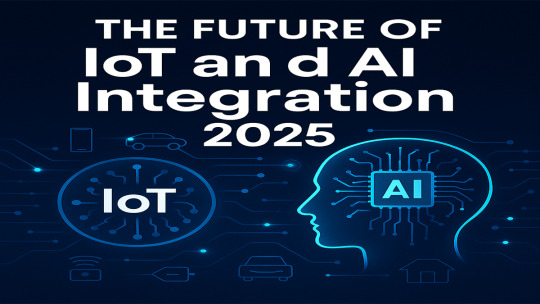
In 2025, the fusion of IoT and AI integration is reshaping how machines communicate, businesses operate, and societies thrive. The convergence of the Internet of Things (IoT) with Artificial Intelligence (AI) is no longer futuristic — it's already here, driving smart cities, industrial automation, and intelligent consumer ecosystems. As IoT and AI integration 2025 takes center stage, industries are leveraging this synergy to optimize operations, reduce human error, and unlock real-time decision-making.
What is IoT and AI Integration?
IoT refers to the network of interconnected devices that collect and share data, while AI enables these devices to analyze, learn, and make autonomous decisions. The integration of IoT and AI brings intelligent automation to devices, enhancing their ability to adapt, predict, and evolve.
How IoT and AI Integration Is Changing the Game in 2025
From healthcare to agriculture, the powerful duo of IoT and AI is revolutionizing how industries function. Here are the top sectors experiencing a transformation:
1. Smart Manufacturing (Industry 4.0)
• Predictive maintenance using AI-driven insights from IoT sensors • Robotics and automation for precision and safety • Real-time production monitoring with automated alerts
2. Healthcare
• Wearables collecting patient vitals with AI diagnosing anomalies • Smart hospitals with automated inventory and energy management • Remote surgery support powered by edge AI and IoT connectivity
3. Smart Cities
• AI-enabled traffic management based on IoT camera feeds • Automated waste management systems • Smart street lighting and energy optimization
4. Agriculture
• AI-driven precision farming based on IoT soil and weather sensors • Livestock monitoring using smart tags • Water and nutrient automation for crops
5. Retail & Supply Chain
• Inventory forecasting using IoT + AI analytics • AI-powered demand prediction • Cold chain monitoring for perishables
Benefits of AI and IoT Integration
• Enhanced Efficiency: Real-time decision-making reduces delays and boosts productivity • Cost Savings: Predictive analytics cuts down maintenance and resource waste • Improved Safety: AI monitors risk parameters from IoT devices to prevent accidents • Better Customer Experience: Personalized services powered by AI insights from IoT data
Challenges in 2025
Despite the rapid growth, there are some hurdles:
• Data Privacy & Security: As more devices connect, vulnerability increases • Infrastructure Requirements: High-speed connectivity and edge computing are necessary • Standardization: Interoperability remains a concern across different ecosystems
The Role of 5G and Edge AI
2025 is witnessing mass adoption of 5G and edge computing, allowing faster, low-latency processing of IoT data. Instead of sending data to the cloud, AI can process information on the edge device itself. This is crucial for time-sensitive applications like autonomous vehicles, smart grids, and medical devices.
Real-World Examples in 2025
• Tata Power uses IoT-AI for grid monitoring and predictive energy distribution. • Apollo Hospitals deploys wearable AI-integrated IoT devices for chronic disease monitoring. • Mahindra Agritech is implementing AI-IoT systems to automate irrigation based on real-time soil data.
The Road Ahead: What to Expect Beyond 2025
As both technologies evolve, we can expect:
• Increased adoption of digital twins • More autonomous decision-making devices • Broader use of generative AI models integrated with IoT for real-time content or data generation
Final Thoughts
IoT and AI integration 2025 is proving to be more than a buzzword—it’s a technological alliance with the power to redefine industries, enhance human capabilities, and create a more efficient and intelligent world. Businesses investing in this synergy today are setting themselves up for long-term success.
As connectivity expands and AI models become more robust, the line between the digital and physical world continues to blur, opening new possibilities for innovation, automation, and sustainability.
In the coming years, the winners in this space will be those who not only adopt the technology but adapt their strategies to leverage it fully.
#tagbin#writers on tumblr#artificial intelligence#technology#tagbin ai solutions#ai trends 2025#Future of IoT and AI Integration 2025#AI and IoT future trends#IoT AI convergence 2025#AI in Internet of Things 2025#Smart devices AI 2025#AI IoT use cases 2025#Artificial intelligence and IoT in business#Tagbin
0 notes
Text
Introduction
The Blood Glucose Monitoring (BGM) devices market is witnessing significant expansion due to the rising global prevalence of diabetes and increasing awareness of health and wellness. As a crucial part of diabetes management, these devices enable individuals to monitor and control their blood glucose levels in real time, thereby helping prevent complications and enhance quality of life. With advancements in technology and growing emphasis on self-care, the BGM market is becoming increasingly sophisticated and user-friendly.
What Are Blood Glucose Monitoring Devices?
Blood glucose monitoring devices are tools that help individuals measure the concentration of glucose in their blood. These are primarily used by people with type 1 and type 2 diabetes, but also by healthcare providers to assess and manage patient health. There are two major types of BGM devices:
Traditional Blood Glucose Meters (BGMs): These require a finger-prick blood sample applied to a test strip.
Continuous Glucose Monitors (CGMs): These are wearable devices that continuously track blood glucose levels throughout the day and night, providing real-time readings and alerts.
Download a Free Sample Report: - https://tinyurl.com/mwajy5x
Key Market Segments
The market can be segmented by:
Product Type: Blood glucose meters, test strips, lancets, continuous glucose monitors
End Users: Hospitals, diagnostic centers, homecare, clinics
Geography: North America, Europe, Asia-Pacific, Latin America, Middle East & Africa
The test strips segment holds the largest market share due to its frequent and recurring usage. However, CGMs are the fastest-growing segment, fueled by their ease of use, data accuracy, and integration with digital platforms.
Market Drivers
1. Rising Prevalence of Diabetes
Diabetes is a major global health concern. According to the International Diabetes Federation (IDF), over 537 million adults were living with diabetes in 2023, a figure projected to rise to 643 million by 2030. This rapidly growing patient pool is driving the demand for blood glucose monitoring solutions for regular self-monitoring and management.
2. Technological Innovations
The shift from traditional finger-stick methods to continuous and non-invasive glucose monitoring systems is revolutionizing the market. Companies are investing heavily in AI-driven analytics, smartphone integration, and sensor technology. Features such as real-time alerts, remote access to data, and cloud connectivity are now common in CGM devices.
3. Increasing Awareness and Preventive Healthcare
People are becoming more health-conscious and proactive about disease management. Awareness campaigns, both public and private, have contributed to increased adoption of BGM devices. The focus on preventive healthcare and early diagnosis is propelling demand, especially in developed economies.
4. Remote Monitoring and Telehealth Integration
The COVID-19 pandemic accelerated the adoption of telemedicine, with remote monitoring becoming a standard component of chronic disease care. Blood glucose monitoring devices now often come with remote data sharing capabilities, allowing physicians to track patients' health and adjust treatments accordingly.
5. Favorable Government Initiatives
Governments and health organizations around the world are promoting diabetes management programs. Subsidies, insurance coverage, and public health campaigns are encouraging the adoption of monitoring devices. For example, the U.S. Centers for Medicare & Medicaid Services (CMS) expanded coverage for CGM devices in recent years.
Market Challenges
1. High Costs of Advanced Devices
Continuous glucose monitoring systems, while more efficient and less invasive, are also more expensive. The cost of sensors, transmitters, and related consumables can be a financial burden for many patients, especially in low- and middle-income countries.
2. Limited Access in Developing Regions
Despite growing awareness, access to BGM devices is limited in many parts of Africa, South Asia, and Latin America. Infrastructural deficits, lower healthcare budgets, and lack of trained professionals contribute to low adoption rates in these regions.
3. Accuracy and Reliability Concerns
Though CGMs have improved, questions still remain about the accuracy and calibration of some models, particularly in extreme conditions such as hypoglycemia or during high-intensity exercise. Regulatory scrutiny and clinical validation continue to be important for building trust among healthcare professionals.
4. Data Privacy and Security
As BGM devices become more connected through apps and the cloud, concerns about data privacy and cybersecurity have increased. Ensuring compliance with standards like HIPAA and GDPR is essential for device manufacturers.
Regional Analysis
North America
North America dominates the BGM devices market, led by the United States. High diabetes prevalence, robust healthcare infrastructure, favorable reimbursement policies, and high-tech adoption are key growth enablers. Major players like Abbott, Dexcom, and Medtronic have a strong foothold here.
Europe
Europe is the second-largest market, with countries like Germany, France, and the UK leading in terms of technological uptake and healthcare support. Government initiatives to combat diabetes and rising aging populations are driving growth.
Asia-Pacific
The Asia-Pacific region is expected to witness the highest growth rate during the forecast period, due to increasing diabetes incidence in countries like India and China. Improving healthcare access, expanding insurance coverage, and the emergence of local manufacturers are major contributors.
Latin America and Middle East & Africa
These regions are gradually embracing BGM technologies. While challenges related to infrastructure and affordability persist, awareness programs and international health initiatives are laying the groundwork for future growth.
Competitive Landscape
The market is moderately consolidated, with leading players investing in product innovation and strategic collaborations. Key players include:
Abbott Laboratories
Dexcom Inc.
F. Hoffmann-La Roche Ltd.
Medtronic plc
Ascensia Diabetes Care Holdings AG
Senseonics Holdings, Inc.
LifeScan Inc.
Recent trends show a focus on wearable tech, non-invasive sensors, and AI-enabled platforms. Partnerships between tech companies and healthcare providers are also becoming more common.
Future Outlook
Looking ahead, the blood glucose monitoring devices market is poised for robust growth. Some anticipated trends include:
Non-invasive monitoring: Research is advancing toward needle-free solutions such as optical and transdermal sensors.
Integration with wearable health devices: Smartwatches and fitness bands may soon incorporate glucose monitoring capabilities.
Personalized health analytics: AI and machine learning will enhance data interpretation and predictive analytics.
Expansion in emerging markets: As awareness and affordability improve, adoption is expected to rise significantly in developing countries.
Conclusion
The blood glucose monitoring devices market is undergoing rapid transformation, driven by a growing diabetic population, technological advancements, and evolving healthcare models. As diabetes becomes more prevalent worldwide, the demand for reliable, convenient, and cost-effective monitoring solutions will continue to rise. With ongoing innovation and strategic investments, the market is set to play a crucial role in the future of personalized and preventive healthcare.
Read Full Report: - https://www.uniprismmarketresearch.com/verticals/healthcare/blood-glucose-monitoring-devices
0 notes
Text
How Digital Signage Is Evolving with IoT and AI Integration?

As time passes by, devices are becoming smarter & “digitaler”. Is that even a term? No worries! With the invasion of IoT & AI, digital signage is advancing beyond mere displays to interactive platforms that offer personalized experiences. AIScreen experts have highlighted that IoT integration elevates audience engagement by 40% and operational adaptability by 35% in digital signage systems across 80 different implementations. For those who bring in the AI-shift requires a refined perspective is required to educate & support clients.
The Rise of Smart Digital Signage
Digital display, traditionally used for advertising and informational purposes in public and private spaces, has evolved into a smart solution that responds to its environment. This transformation is driven by IoT-enabled sensors and AI algorithms that allow digital display systems to collect, analyze, and act on data from their surroundings. These smart displays can now adapt content based on foot traffic, weather, audience demographics, or even inventory levels.
For instance, a retail store in New York can use AI-powered digital signage to adjust promotions in real time depending on customer demographics captured via in-store cameras. If the system identifies a higher number of younger shoppers during certain hours, it might push promotions for trending items or fashion-forward collections.
Real-Time Data and Predictive Capabilities

[ Source - AIScreen]
One of the most significant advantages of combining digital signage with IoT and AI is the ability to harness real-time and predictive data. According to a report by MarketsandMarkets, the global digital board market is projected to grow from $20.8 billion in 2022 to $29.6 billion by 2027, driven largely by smart technologies. In the U.S., this trend is especially strong in sectors like retail, healthcare, education, and transportation.
AI integration enables media screen systems to go beyond passive content broadcasting. Predictive analytics can forecast customer behavior, optimize content schedules, and even predict system failures, leading to reduced downtime and enhanced customer satisfaction. A smart digital menu in a quick-service restaurant, for example, can promote breakfast items during peak morning hours based on historical sales data and footfall trends.
Enhanced Customer Experience
Customer engagement is a primary focus for businesses, and signage screen equipped with IoT and AI delivers highly personalized experiences. These technologies enable context-aware messaging, where content changes based on variables like location, weather, time of day, and user preferences.
Take the case of a fitness center in California: smart digital signage might display workout tips or promotions based on the type of classes scheduled for that day, adjusting content dynamically for different age groups or fitness levels. AI helps tailor messages, while IoT ensures the right data is fed into the system for context.
Operational Efficiency and Cost Savings
From an operational perspective, digital signage with IoT and AI integration significantly enhances efficiency. Businesses can remotely manage content across multiple locations, reducing the need for manual updates. Sensors can monitor display performance, trigger maintenance alerts, or even adjust brightness based on ambient light, thereby conserving energy.
Moreover, AI helps in analyzing which types of content perform best in specific scenarios, enabling more targeted and effective campaigns. This not only boosts ROI but also minimizes content fatigue, ensuring that audiences remain engaged.
Applications Across Sectors

In healthcare, display boards are being used for wayfinding, patient check-ins, and educational messaging. IoT devices gather patient flow data, and AI adjusts signage content accordingly to reduce wait times and improve the experience. In the education sector, universities in the U.S. are leveraging smart signage for dynamic class schedules, emergency notifications, and campus news.
Transportation hubs are another prime example. Airports use digital signage to manage passenger flow efficiently. AI predicts peak hours, while IoT sensors detect crowd density, prompting the signage to offer real-time directions, gate changes, or promotional offers tailored to specific demographics.
Security and Data Privacy
As with any technology that collects data, smart signage systems must adhere to strict data security and privacy protocols. U.S. businesses integrating AI and IoT into their signage solutions must comply with regulations like the California Consumer Privacy Act (CCPA). Ensuring transparent data collection and anonymization practices is essential to maintain public trust.
The Future of Digital Signage

Looking forward, the convergence of media screen with emerging technologies like 5G, augmented reality (AR), and machine learning will unlock even more possibilities. Imagine smart signage that uses facial recognition to identify returning customers and display loyalty rewards, or AR-enabled screens that offer immersive product demos in real-time.
For C-suite executives, startup entrepreneurs, and U.S. managers, the message is clear: digital signage is no longer a static tool—it’s a strategic asset. By integrating IoT and AI, businesses can enhance communication, optimize operations, and deliver deeply personalized experiences.
Conclusion
Digital signage is moving from the periphery to the core of modern business strategy. With IoT and AI integration, it offers not only enhanced customer engagement but also operational intelligence, cost efficiency, and future scalability. As technology continues to evolve, businesses that invest in smart digital boards today will be the ones that define tomorrow’s customer experience landscape.
Whether you're a retailer aiming to personalize promotions, a hospital seeking to improve patient journeys, or a university wanting to streamline communication, smart digital display is a tool worth your attention.
Uncover the latest trends and insights with our articles on Visionary Vogues
0 notes
Text
Hybrid Cloud Application: The Smart Future of Business IT
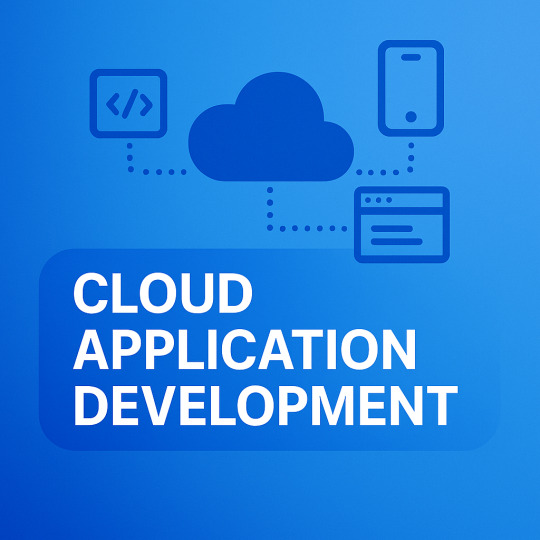
Introduction
In today’s digital-first environment, businesses are constantly seeking scalable, flexible, and cost-effective solutions to stay competitive. One solution that is gaining rapid traction is the hybrid cloud application model. Combining the best of public and private cloud environments, hybrid cloud applications enable businesses to maximize performance while maintaining control and security.
This 2000-word comprehensive article on hybrid cloud applications explains what they are, why they matter, how they work, their benefits, and how businesses can use them effectively. We also include real-user reviews, expert insights, and FAQs to help guide your cloud journey.
What is a Hybrid Cloud Application?
A hybrid cloud application is a software solution that operates across both public and private cloud environments. It enables data, services, and workflows to move seamlessly between the two, offering flexibility and optimization in terms of cost, performance, and security.
For example, a business might host sensitive customer data in a private cloud while running less critical workloads on a public cloud like AWS, Azure, or Google Cloud Platform.
Key Components of Hybrid Cloud Applications
Public Cloud Services – Scalable and cost-effective compute and storage offered by providers like AWS, Azure, and GCP.
Private Cloud Infrastructure – More secure environments, either on-premises or managed by a third-party.
Middleware/Integration Tools – Platforms that ensure communication and data sharing between cloud environments.
Application Orchestration – Manages application deployment and performance across both clouds.
Why Choose a Hybrid Cloud Application Model?
1. Flexibility
Run workloads where they make the most sense, optimizing both performance and cost.
2. Security and Compliance
Sensitive data can remain in a private cloud to meet regulatory requirements.
3. Scalability
Burst into public cloud resources when private cloud capacity is reached.
4. Business Continuity
Maintain uptime and minimize downtime with distributed architecture.
5. Cost Efficiency
Avoid overprovisioning private infrastructure while still meeting demand spikes.
Real-World Use Cases of Hybrid Cloud Applications
1. Healthcare
Protect sensitive patient data in a private cloud while using public cloud resources for analytics and AI.
2. Finance
Securely handle customer transactions and compliance data, while leveraging the cloud for large-scale computations.
3. Retail and E-Commerce
Manage customer interactions and seasonal traffic spikes efficiently.
4. Manufacturing
Enable remote monitoring and IoT integrations across factory units using hybrid cloud applications.
5. Education
Store student records securely while using cloud platforms for learning management systems.
Benefits of Hybrid Cloud Applications
Enhanced Agility
Better Resource Utilization
Reduced Latency
Compliance Made Easier
Risk Mitigation
Simplified Workload Management
Tools and Platforms Supporting Hybrid Cloud
Microsoft Azure Arc – Extends Azure services and management to any infrastructure.
AWS Outposts – Run AWS infrastructure and services on-premises.
Google Anthos – Manage applications across multiple clouds.
VMware Cloud Foundation – Hybrid solution for virtual machines and containers.
Red Hat OpenShift – Kubernetes-based platform for hybrid deployment.
Best Practices for Developing Hybrid Cloud Applications
Design for Portability Use containers and microservices to enable seamless movement between clouds.
Ensure Security Implement zero-trust architectures, encryption, and access control.
Automate and Monitor Use DevOps and continuous monitoring tools to maintain performance and compliance.
Choose the Right Partner Work with experienced providers who understand hybrid cloud deployment strategies.
Regular Testing and Backup Test failover scenarios and ensure robust backup solutions are in place.
Reviews from Industry Professionals
Amrita Singh, Cloud Engineer at FinCloud Solutions:
"Implementing hybrid cloud applications helped us reduce latency by 40% and improve client satisfaction."
John Meadows, CTO at EdTechNext:
"Our LMS platform runs on a hybrid model. We’ve achieved excellent uptime and student experience during peak loads."
Rahul Varma, Data Security Specialist:
"For compliance-heavy environments like finance and healthcare, hybrid cloud is a no-brainer."
Challenges and How to Overcome Them
1. Complex Architecture
Solution: Simplify with orchestration tools and automation.
2. Integration Difficulties
Solution: Use APIs and middleware platforms for seamless data exchange.
3. Cost Overruns
Solution: Use cloud cost optimization tools like Azure Advisor, AWS Cost Explorer.
4. Security Risks
Solution: Implement multi-layered security protocols and conduct regular audits.
FAQ: Hybrid Cloud Application
Q1: What is the main advantage of a hybrid cloud application?
A: It combines the strengths of public and private clouds for flexibility, scalability, and security.
Q2: Is hybrid cloud suitable for small businesses?
A: Yes, especially those with fluctuating workloads or compliance needs.
Q3: How secure is a hybrid cloud application?
A: When properly configured, hybrid cloud applications can be as secure as traditional setups.
Q4: Can hybrid cloud reduce IT costs?
A: Yes. By only paying for public cloud usage as needed, and avoiding overprovisioning private servers.
Q5: How do you monitor a hybrid cloud application?
A: With cloud management platforms and monitoring tools like Datadog, Splunk, or Prometheus.
Q6: What are the best platforms for hybrid deployment?
A: Azure Arc, Google Anthos, AWS Outposts, and Red Hat OpenShift are top choices.
Conclusion: Hybrid Cloud is the New Normal
The hybrid cloud application model is more than a trend—it’s a strategic evolution that empowers organizations to balance innovation with control. It offers the agility of the cloud without sacrificing the oversight and security of on-premises systems.
If your organization is looking to modernize its IT infrastructure while staying compliant, resilient, and efficient, then hybrid cloud application development is the way forward.
At diglip7.com, we help businesses build scalable, secure, and agile hybrid cloud solutions tailored to their unique needs. Ready to unlock the future? Contact us today to get started.
0 notes
Text
Addsoft Technologies: Types, Uses, and Illustrations of Thin Clients
In today’s rapidly digitizing business world, organizations need smarter, more cost-effective ways to deliver computing power across their workforce. Thin Clients are proving to be a key part of this shift, offering a simpler, more efficient alternative to traditional desktop setups.
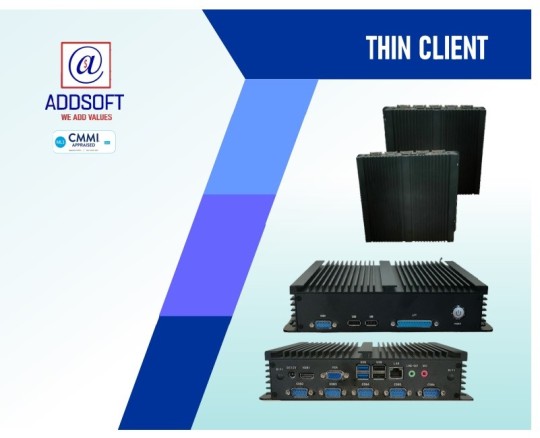
At Addsoft Technologies, we help businesses harness the true potential of Thin Client technology for improved performance, security, and scalability.
In this blog, we explain what Thin Clients are, their types, real-world applications, and share practical examples.
What is a Thin Client?
A Thin Client is a lightweight computer that relies on a centralized server for processing power and data storage. Unlike traditional PCs that manage everything locally, Thin Clients access applications, files, and even computing resources remotely through a network.
They are ideal for businesses seeking simplified IT management, enhanced security, and lower operational costs.
Types of Thin Clients
Thin Clients come in several forms, depending on the deployment and business needs:
1. Hardware Thin Clients
These are standalone physical devices that connect to a remote server. They are durable, energy-efficient, and easy to deploy in large numbers.
2. Software Thin Clients
Existing PCs or laptops can be transformed into Thin Clients using specialized software that locks down local operations and redirects activities to the server.
3. Zero Clients
A type of Thin Client with no local storage or configuration. It connects directly to a server or a virtual desktop infrastructure (VDI) and offers the highest level of simplicity and security.
4. Web Thin Clients
Devices that access applications purely through a web browser. These are ideal for cloud-based operations where minimal local processing is required.
Applications of Thin Clients
Thin Clients are versatile and can be used across industries and functions:
✅ Corporate Offices
Deploy Thin Clients for employee workstations to reduce maintenance costs and enhance centralized management.
✅ Education
In schools and universities, Thin Clients are used in computer labs, libraries, and administration offices for easy management and reduced downtime.
✅ Healthcare
Hospitals use Thin Clients for secure access to patient data, ensuring confidentiality and faster system recovery in case of hardware failure.
✅ Banking and Finance
Banks leverage Thin Clients at teller stations and customer service desks to ensure secure, reliable access to central databases.
✅ Manufacturing
On factory floors, Thin Clients withstand harsh environments while enabling real-time access to production and inventory systems.
✅ Public Sector
Government agencies use Thin Clients for cost-effective, scalable IT infrastructure that meets strict data security requirements.
Real-World Examples of Thin Client Deployment
Educational Institutions: Universities replacing hundreds of PCs with Thin Clients to lower energy consumption and simplify IT maintenance.
Healthcare Networks: Hospitals equipping nurses' stations and consultation rooms with Thin Clients to access Electronic Health Records (EHR) securely.
Corporate Enterprises: Companies deploying Thin Clients across multiple office locations for unified desktop management and disaster recovery readiness.
Call Centers: Customer support centers using Thin Clients to quickly set up, monitor, and manage hundreds of agent workstations.
Why Choose Addsoft Technologies for Your Thin Client Solutions?
At Addsoft Technologies, we specialize in:
Custom Thin Client setups tailored to your organizational needs
Seamless integration with cloud and on-premise servers
Ongoing support and maintenance to ensure maximum uptime
Secure configurations to protect sensitive data
With our expertise, you can build a more efficient, scalable, and secure IT environment—reducing costs while boosting performance.
Final Thoughts
As businesses move toward cloud-first strategies and virtualization, Thin Clients are becoming an essential part of the IT ecosystem. Addsoft Technologies is here to help you leverage Thin Client solutions to stay competitive, secure, and future-ready.
Ready to streamline your IT infrastructure?
Contact Addsoft Technologies today to discover how our Thin Client solutions can transform your workplace.
#blog#article#news#business#technologies#software#electronic#productivity software#enterprise software
0 notes
Text
Revolutionize Your Daily Life with Cutting-Edge IoT Devices – Discover How!
Revolutionize Your Daily Life with Cutting-Edge IoT Devices – Discover How!
In today's fast-paced world, the integration of the Internet of Things (IoT) devices into our daily lives is not just a futuristic concept but a present reality that is rapidly transforming how we interact with our environment. These innovative gadgets are the epitome of convenience and efficiency, offering a seamless blend of connectivity and automation that can significantly enhance our daily routines. The Internet of Things (IoT) represents a network of physical objects—ranging from household appliances to industrial equipment—that are embedded with sensors, software, and other technologies to connect and exchange data with other devices and systems over the internet. This interconnectedness allows for a level of communication between devices that was once the stuff of science fiction, but is now an accessible and practical tool for optimizing our lifestyles.

Imagine waking up to a smart home where your IoT-enabled coffee maker has already brewed your morning cup just the way you like it, thanks to your sleep tracker signaling that you're about to wake up. Your smart thermostat has adjusted the temperature to your preferred comfort level, and as you step out of bed, the lights gradually brighten to ease you into the day. This is just the tip of the iceberg when it comes to the capabilities of Internet of Things IoT devices. From smart refrigerators that can keep track of your groceries and suggest recipes based on what's inside, to wearable fitness trackers that monitor your health metrics and provide personalized workout plans, the potential for IoT devices to revolutionize your daily life is immense.
Moreover, IoT devices are not limited to personal use; they have profound implications for various industries. In agriculture, for example, IoT sensors can monitor soil moisture levels and automate irrigation systems, ensuring optimal crop growth while conserving water. In healthcare, IoT devices can enable remote patient monitoring, allowing healthcare providers to track patients' vital signs in real-time and respond to any changes swiftly, potentially saving lives.
The security of your home and loved ones can also be enhanced with IoT devices. Smart locks can be controlled remotely, giving you the ability to lock or unlock your doors from anywhere in the world. Surveillance cameras equipped with motion sensors can send alerts to your smartphone if unexpected activity is detected, providing peace of mind whether you're at home or away.
The integration of IoT devices into our daily lives is not without its challenges, particularly concerning data privacy and security. As these devices collect and transmit personal data, it is crucial to ensure that robust security measures are in place to protect against unauthorized access and cyber threats. Manufacturers and users alike must prioritize the security of their Internet of Things IoT devices to maintain trust and reliability in this interconnected ecosystem.
In conclusion, the advent of cutting-edge IoT devices is revolutionizing our daily lives by offering unparalleled convenience, efficiency, and personalization. As we continue to embrace these smart technologies, we can look forward to a future where our homes, workplaces, and cities are more responsive to our needs, creating a more connected and intelligent world. The Internet of Things is not just a technological trend; it is a transformative force that is reshaping our existence, one smart device at a time.
0 notes
Text
How IoT App Development Companies Are Powering Smart Innovation

Introduction
In the era of digital transformation, connectivity goes far beyond smartphones and laptops. With billions of devices getting interconnected, the Internet of Things (IoT) has become a driving force for innovation. Businesses across industries—from healthcare and agriculture to manufacturing and logistics—are increasingly adopting IoT to gain real-time insights and improve operations. This is where IoT App Development Companies come into the spotlight. These companies provide specialized services that help businesses design, build, and deploy intelligent applications tailored to IoT ecosystems.
But not all development companies are created equal. The right partner can accelerate innovation, improve product quality, and provide scalable, secure solutions. Let’s explore how these companies are making an impact and what sets them apart.
Delivering Tailored IoT Technology Solutions
The best IoT App Development Companies focus on more than just connectivity—they offer end-to-end IoT Technology Solutions that are secure, scalable, and tailored to unique business needs. These companies typically provide services that cover everything from device integration and cloud computing to analytics and user interface design.
IoT applications need to handle vast amounts of data in real-time. This requires the right infrastructure and tools to ensure reliable communication between devices, platforms, and users. IoT developers often work with popular platforms like AWS IoT, Google Cloud IoT Core, and Microsoft Azure IoT to deliver efficient, enterprise-grade solutions.
Estimating Budget with IoT App Cost Calculator
A major hurdle in adopting IoT solutions is understanding the cost involved. Leading IoT App Development Companies help clients estimate their budgets with tools like an IoT App Cost Calculator. These tools consider factors like device type, data complexity, cloud usage, and integration needs to provide a realistic estimate.
With this insight, businesses can plan their IoT investments better, evaluate the ROI, and prioritize features. These cost calculators also help compare different engagement models—fixed cost vs. hourly pricing—so clients make informed decisions before starting their development journey.
Collaborating with an Experienced IoT Software Development Company
Working with an established IoT Software Development Company ensures better risk mitigation and delivery timelines. These companies bring domain knowledge and technical expertise that allow them to build robust, secure, and compliant applications.
They understand how to collect and process data from sensors, cameras, and other IoT-enabled devices while ensuring minimal latency and maximum uptime. Plus, they design systems that can be easily scaled across multiple locations or devices without compromising performance or security.
Transforming Industries with IoT App Development Services
From predictive maintenance in factories to smart irrigation systems in agriculture, IoT App Development Companies are delivering game-changing solutions. With Transforming The Future with IoT App Development Services, these firms help businesses automate processes, reduce human errors, and improve customer experiences.
IoT services often involve working closely with AI and machine learning to gain predictive insights. For example, in logistics, these insights help manage inventory levels, forecast demand, and avoid stockouts. In healthcare, they enable remote patient monitoring, enhancing care quality and efficiency.
Partnering with Top IoT Development Companies
Not every vendor offers the same level of innovation. Businesses looking to implement IoT solutions must choose from the Top IoT Development Companies that have proven track records and diverse portfolios.
These companies often bring unique value propositions—such as partnerships with hardware vendors, in-house analytics teams, or proprietary platforms that reduce time-to-market. They also ensure their solutions comply with industry regulations like HIPAA, GDPR, and ISO standards, which is essential in data-sensitive industries.
Following a Complete Guide For IoT Software Development Services
To launch a successful IoT solution, it’s essential to follow a Complete Guide For IoT Software Development Services. Reputed companies offer this as part of their consultation to educate clients on the lifecycle of IoT app development.
From initial business analysis and hardware compatibility checks to prototyping, testing, and scaling—these steps ensure your solution is viable and sustainable in the long term. A comprehensive guide also helps stakeholders align better and track development milestones effectively.
Conclusion
IoT App Development Companies are playing a crucial role in enabling smarter homes, cities, and industries. Their ability to merge software, hardware, and data analytics into a unified platform allows businesses to gain real-time insights, automate tasks, and enhance productivity.
By leveraging IoT Technology Solutions, estimating budgets using an IoT App Cost Calculator, and collaborating with an experienced IoT Software Development Company, organizations can transform operations and gain competitive advantages. Whether you're working with one of the Top IoT Development Companies or just exploring options through a Complete Guide For IoT Software Development Services, the future looks increasingly connected.
Choosing the right development partner isn't just a technical decision—it's a strategic move toward long-term digital transformation. With the right guidance and a robust implementation plan, your business can fully harness the potential of IoT and thrive in a connected ecosystem.
0 notes